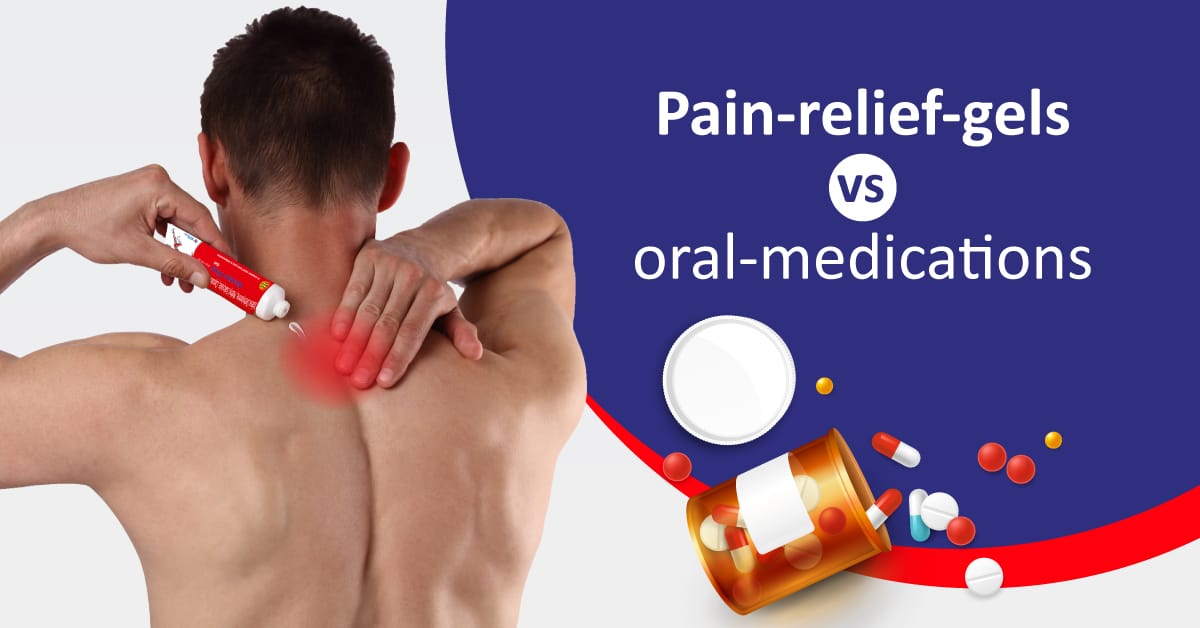

Sep 15, 2025

Pain is an unavoidable part of life, affecting millions of people worldwide. From minor muscle soreness to chronic conditions like arthritis, headaches, or back pain, managing discomfort effectively is essential for maintaining quality of life. Two popular options for pain relief are oral medications and topical pain relief gels. Both approaches offer significant benefits, but many people wonder which one is safer, faster, and more effective.
In this blog, we will dive deep into both options, explore how they work, examine their effectiveness, and analyze their safety profiles. By the end, you’ll have a clearer understanding of which pain relief solution is suitable for different types of pain.
Oral Medications
Oral medications are among the most commonly used pain relief solutions. They work systemically, meaning they enter the bloodstream and act throughout the entire body. Popular oral painkillers include:
These medications are convenient, widely available, and effective for various types of pain, including headaches, arthritis, or muscle soreness.
Topical Pain Relief Gels
Topical gels, creams, and ointments are applied directly to the skin over the painful area. Popular types include:
These gels provide targeted relief by penetrating the skin and reaching underlying muscles or joints. Since they act locally, they reduce the risk of systemic side effects commonly seen with oral medications.
Topical gels are particularly effective for localized pain, such as knee osteoarthritis, shoulder strains, back pain, or sports injuries. They also allow patients to apply pain relief directly where it’s needed, providing fast and convenient results.
Mechanism of Oral Medications
Oral medications work by entering the bloodstream and affecting the body as a whole:
While oral medications are powerful, systemic absorption means that all organs are exposed, which can lead to unwanted side effects, particularly with long-term use.
Mechanism of Pain Relief Gels
Pain relief gels work locally by targeting the affected area. Key mechanisms include:
Because gels work directly at the site of pain, lower doses are required, and relief can often be felt within minutes to an hour.
Both oral medications and topical gels are effective, but their effectiveness depends on the type and location of pain:
| Type | Effectiveness | Best For | Duration |
|---|---|---|---|
| Oral Medications | High systemic effect | Widespread pain, chronic conditions | Several hours |
| Pain Relief Gels | Moderate localized effect | Joint pain, sprains, muscle strains | 2-4 hours, varies by formulation |
Key takeaway: For localized pain, gels can be as effective as oral medications and sometimes preferable due to fewer systemic effects. For severe, widespread, or chronic pain, oral medications may provide faster and more comprehensive relief.
Oral Medication Risks
Oral medications, especially NSAIDs and opioids, can lead to several risks:
These risks make long-term or frequent use of oral medications a concern, especially for people with pre-existing health conditions.
Topical Gel Safety
Topical gels are generally safer due to localized action:
Overall, topical gels offer an effective and low-risk alternative for managing pain without compromising internal organ health.
Both oral medications and topical pain relief gels have unique advantages and limitations. Oral medications are highly effective for widespread or severe pain but carry higher systemic risks. Pain relief gels are ideal for localized pain, providing quick relief with fewer side effects.
Ultimately, the choice depends on pain type, severity, health conditions, and personal preference. Consulting a healthcare professional ensures that your pain management approach is both safe and effective, helping you maintain comfort and quality of life.

‘Sign up’ for our newsletter to unlock exclusive updates, special offers, and wellness tips. Be the first to discover new products and promotions. Join us on the path to an active and pain-free lifestyle !